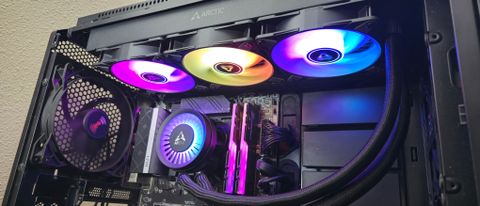Tom's Hardware Verdict
To put it bluntly, the Liquid Freezer III is unimpressive.
Pros
- +
Low introductory price
- +
Low noise levels for an AIO
Cons
- -
Better options exist for the same price, even with launch discounts
- -
Mediocre noise normalized performance
- -
Fails stress testing
- -
Forced use of a warranty-voiding contact frame
- -
Only supports LGA 1700 and AM4/AM5, older sockets are unsupported
- -
Performance comparable to good air coolers
Why you can trust Tom's Hardware
German company Arctic has been a mainstay in the PC cooling space ever since its founding in 2001. Today the company is known for its Freezer Air & Liquid CPU Coolers, MX thermal pastes, fans, as well as custom Accelero GPU coolers.
The company’s Liquid Freezer II AIOs have long been the favorite of many enthusiasts, and today we’ll be looking at their successor, Arctic’s new Liquid Freezer III 280mm and 360mm AIOs. Can they handle the heat of Intel’s Core i7-13700K and earn a spot on our best AIO Coolers list? We’ll put them through testing to find out. But first, here are the coolers’ specifications, direct from Arctic.

Specs
| Header Cell - Column 0 | Liquid Freezer III 360mm | Liquid Freezer III 280mm | Liquid Freezer III 240mm |
|---|---|---|---|
| Launch MSRP | $90.08 | $86.23 | $76.99 |
| Heatsink Material | Aluminum | Aluminum | Aluminum |
| Rated Lifespan | 6-year warranty | 6-year warranty | 6-year warranty |
| Socket Compatibility | Intel LGA 1700 AMD: AM5/AM4 | Intel LGA 1700 AMD: AM5/AM4 | Intel LGA 1700 AMD: AM5/AM4 |
| Base | Copper Base | Copper Base | Copper Base |
| Max TDP with Intel’s i7-13700K (Our Testing) | 234W | 233W | 219W |
| Dimensions (fans installed) | 398mm (L) x 120 mm (W) x 63mm (D) | 317mm (L) x 138 mm (W) x 65mm (D) | 277 (L) x 120 (W) x 63mm (D) |
Features of Arctic’s Liquid Freezer III AIOs
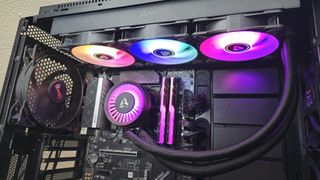
➡️ Available in black or white, with or without RGB
Arctic recognizes that PC users have a diverse set of aesthetic tastes. As such, the Liquid Freezer is available in black or white, and with or without ARGB.

➡️ Available in 240, 280, 360, and 420mm sizes
The Arctic Liquid Freezer is available in a variety of sizes to best fit various cases and cooling needs. The picture below shows the 240, 280, and 360mm next to each other to give you an idea of how much additional radiator area is gained with the larger units.
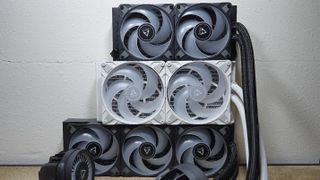
➡️ Full RAM Compatibility
As with most AIOs on the market, the Liquid Freezer III does not impede or overhang DIMM slots in any manner – allowing installation of all sizes of DDR4 and DDR5 RAM, no matter how tall.
➡️ Upgraded VRM fan, with (optional) separate PWM control
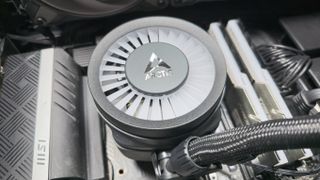
One of the unique features of Arctic’s Liquid Freezer lineup has been its VRM fan. This model’s PWM fan has been upgraded and, unlike previous revisions, it’s easily removable, thanks to a magnetic connection. Another improvement over previous models is the optional ability to control the VRM fan, pump, and radiator fans separately. However, you’re not forced to run them separately. Arctic includes two cords that connect to the CPU base: one that separates the PWM controls for the 3 parts, and one that runs all three at the same speeds.

➡️ Arctic P12 and P14 fans
One of the most important aspects of a cooler are the included fans, which directly impact both thermal performance and noise levels. These are unchanged compared to the Liquid Freezer II, utilizing Arctic’s P12 fans for the 240 & 360mm version of the Liquid Freezer III, and Arctic P14 fans for the 280mm and 420mm versions of the cooler.
| Header Cell - Column 0 | Arctic P12 PWM | Arctic P14 PWM |
|---|---|---|
| Dimensions | 120 x 120 x 25mm | 140 x 140 x 27 |
| Fan Speed | Up to 1800 RPM | Up to 1700 RPM |
| Air Flow | Up to 56.3 CFM | Up to 72.8 CFM |
| Air Pressure | Up to 2.2 mmH2O | Up to 2.4 mmH20 |
| Bearing Type | FDB Bearing | FDB Bearing |
| Lighting | Optional | Optional |
| MFFT | 6-year warranty | 6-year warranty |
Packing and included contents
The packaging of the Liquid Freezer III is a bit different than most, but utilizes cardboard and plastic coverings. At the top, you’ll find the VRM fan and CPU block next to a box containing the accessories and mounting equipment. The fans and radiator are underneath these, separated by cardboard.
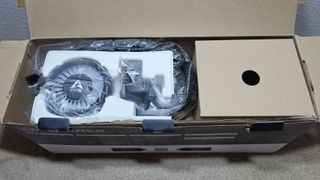
Included with the cooler are the following:
- Radiator with pre-installed fans
- VRM fan
- Mounting for modern AMD and Intel Platforms
- LGA 1700 contact frame
- Thermal Paste
- PWM splitter cord and all-in-one cord (see installation section)
- Mounting accessories
LGA 1700 installation
The installation of the Liquid Freezer III is like none other on the market, as it requires the use of a custom LGA 1700 contact frame. This is both a pro and a con, depending on how you look at it. As a cooling reviewer, I use an LGA 1700 contact frame on my benchmarking system to ensure consistency in testing results.
But I seriously disapprove of this behavior. I don’t feel that the average builder or upgrader should be required to bother with the hassle of using a contact frame. Not only can this potentially void your motherboard’s warranty, but forum users have reported that minor mistakes with the installation of these frames can introduce instability that most commonly manifests as memory errors. Of course, that’s not going to happen with everyone. But forcing users to remove the stock socket mount in favor of a frame just adds unnecessary complexity that could also lead to performance issues.
On top of that, it would have been an easy thing for Arctic to make the cooler work on these systems without the use of their contact frame, by simply drilling two holes into the existing mounting bars included with AMD systems and to include a backplate. This would provide the additional benefit of supporting not just LGA 1700, but also older LGA 1200-based systems.
1. The first thing you’ll need to do for installation is to remove the default CPU socket. You’ll need something to keep everything secure while doing this. I used another CPU cooler’s motherboard backplate, as the standoffs included helped grip the socket and keep everything in place.
2. Place the contact frame on top of the CPU, and secure it with the included screws.
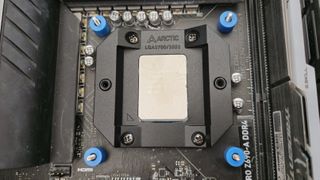
3. Place the mounting bars on top of the standoffs and secure them with the included screws.
4. Next, I’d advise securing the radiator to the computer case.
5. You’ll need to apply thermal paste to the CPU before proceeding further – and if you're unsure how to do that, see our How to Apply Thermal Paste primer.
6. Secure the contact plate against the CPU using a screwdriver, and then insert the PWM cord into the side of the pump.
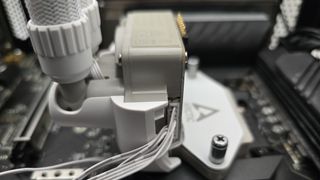
7. Place the VRM fan on top of the pump, and then connect the PWM and aRGB headers to your motherboard.

8. Turn on your computer, and you’re good to go.
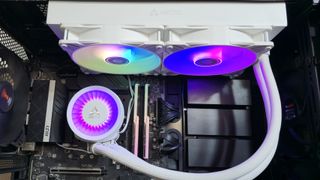
LGA1700 Socket Bending
There are many factors other than the CPU cooler that can influence your cooling performance, including the case you use and the fans installed in it. A system's motherboard can also influence this, especially if it suffers from bending, which results in poor cooler contact with the CPU.
Included with the Liquid Freezer III AIOs is an LGA 1700 contact frame which is mandatory for installation of these coolers. With other coolers tested in this review, we’ve installed Thermalright’s LGA 1700 contact frame into our testing rig, in order to prevent bending from impacting our cooling results. But again, socket bending is more likely to happen if you’re installing several coolers on a motherboard for things like testing than it is if you just install a cooler two or three times over the lifetime of your board.
If your motherboard is affected by bending, your thermal results will be worse than those shown below. Not all motherboards are affected equally by this issue. I tested Raptor Lake CPUs in two motherboards. While one of them showed significant thermal improvements after installing Thermalright’s LGA1700 contact frame, the other motherboard showed no difference in temperatures whatsoever! Check out our review of the contact frame for more information
Testing methodology
Today's highest-end CPUs, whether Intel or AMD, are difficult to cool in intensive workloads. In the past. reaching 95 degrees Celsius or more on a desktop CPU might have been a cause for concern. But with today’s top-end CPUs, this is considered normal operation. Similar behavior has been present in laptops for years due to cooling limitations in tight spaces.
All testing is performed with a 23 degrees Celsius ambient room temperature. Multiple thermal tests are run on each CPU to test the cooler in a variety of conditions, and acoustic measurements are taken with each result. These tests include:
1. Noise-normalized testing at low noise levels
2. “Out-of-the-box”/default configuration thermal & acoustics testing
a. No power limits enforced
b. Because CPUs hit TJMax in this scenario, the best way to compare cooling strength is by recording the total CPU package power consumption.
3. Thermal & acoustic testing in power-limited scenarios
a. Power limited to 175W to emulate a medium-intensity workload
b. Power limited to 125W to emulate a low-intensity workload
The thermal results included are for 10-minute testing runs. To be sure that was sufficiently long to tax the cooler, we tested both Thermalright’s Assassin X 120 R SE and DeepCool’s LT720 with a 30-minute Cinebench test with Intel’s i9-13900K for both 10 minutes and 30 minutes. The results didn’t change much at all with the longer test: The average clock speeds maintained dropped by 29 MHz on DeepCool’s LT720 and 31 MHz on Thermalright’s Assassin X 120 R SE. That’s an incredibly small 0.6% difference in clock speeds maintained, a margin of error difference that tells us that the 10-minute tests are indeed long enough to properly test the coolers.
Testing configuration – Intel LGA1700 platform

Albert Thomas is a contributor for Tom’s Hardware, primarily covering CPU cooling reviews.

Intel closing in on $11 billion deal for Ireland factory funding — Apollo set to pay out 5x Intel's funding goal

Samsung and SK hynix abandon DDR3 production to focus on unrelenting demand for HBM3

Rockstar's original Red Dead Redemption and its expansion spotted in launcher files — Windows gamers may finally get a remastered release
-
-Fran- Come on Albert, I'm sure you're mad they bundled a contact frame and didn't let you use yours! :DReply
Joking aside, quite shocking to see these numbers. I'm guessing since you've always been testing with the contact frame, the fact they're bundling it gives them no real advantage over the others which rely on the normal ILM instead.
Would you have time or energy to re-test them in an AMD platform using whatever they bundle for it?
Regards, -
Albert.Thomas Reply
Unfortunately, no.-Fran- said:Would you have time or energy to re-test them in an AMD platform using whatever they bundle for it?
I don't think that the results would be significantly different and I'm behind on testing other products because of how much extra retesting this review took. -
UnforcedERROR This is a spectacular letdown, especially considering it's attractive relative to the previous version. It's somewhat baffling that a company who's been in the enthusiast space as long as Arctic would do so poorly on the follow-up to one of the highest recommended products in years. I'd gladly take a 3rd-gen "ugly" version of the performance was there, and obviously other people felt the same way about the 2nd-gen.Reply -
thestryker I'm a little disappointed in the results, but they're not really shocking to me. Hardware Canucks had it middle of the pack on their Intel testing, but towards the top on AMD. TPU also had it middle of the road on LGA1700. After seeing the GN review I can't help but wonder if the issue is the contact frame, but there's no way to find out (could try a LFII and if it performs better would answer that question to some degree). I understand why they went with the contact frame design, but I think it was a mistake just the same.Reply
The LFIII really strikes me as the best AMD choice and an average Intel choice. The discounted pricing would probably make it an okay Intel buy, but I don't think I'd buy one with regular pricing. -
RubberMallet I have the 420mm version of this installed on a 14900K. It is able to cool 5.7ghz multicore cinebench runs @ 290W in mid 80s, without any thermal throttling. (This is 15C better than my old AIO which would hit 100C under this load even with a contact frame.) By my estimation, it will cool 325W before throttling and do it quietly. It can cool 200W gaming loads silently.Reply
I dont understand how TH is getting thermal throttling at 230-235W with the 280/360 versions.
As you can see, they are the quietest in the test, which indicates the slowest fans. The best performing AIOs are also loudest, indicating higher power fans. If he tested the RGB versions, those fans are known to have lower rpm than the non-rgb and probably explains the results.
Could the stock fans be that bad? Is the goal to get buyers to purchase additional upgrade fans?
I have always trusted TH; this is the first article that leads me to question that trust. Even with the P12 argb fans, it is impossible to believe that a 360mm thermal throttles at 235W. Even the lowest, spec 360 AIOs from two generations ago did much better than that.
The noise/performance is as expected, but the low headroom is what is hard to believe. Did he have the fans/pump on 100% at max cpu load? The only way to explain this is tester error.
(The cooler a cpu is running, the less watts it will draw at a given clock speed. If the 13700K is maxed out and drawing 235W, that is better than a maxed out 13700K drawing 240W, which indicates it is running hotter. )
They don't list ambient temp (no calibration), so my guess is that their whole database of cooling results are not temp normalized, and worthless. -
35below0 Reply
Because your cooler didn't get a nice review?RubberMallet said:I have always trusted TH; this is the first article that leads me to question that trust. Even with the P12 argb fans, it is impossible to believe that a 360mm thermal throttles at 235W. Even the lowest, spec 360 AIOs from two generations ago did much better than that.
A few other reviews also showed LF III is underwhelming. TH methodology exposed it further.
There are limits to every test.
I'm not sure how you can use one result to completely lose trust. There's lots to criticise TH articles and reviews over, but you're burying results as worthless even though you have not tested the cooler in other configurations than your own.
The paranoia or accusations of steering users to upgrade packs or away from Arctic are werid.
In addition, the contact frame, price, socket support ar other things listed as cons. And those are not performance related.
Why am i even defending TH ? -
RubberMallet Reply
Its not that the results are bad, it is that they are so bad to defy explanation.35below0 said:Because your cooler didn't get a nice review?
A few other reviews also showed LF III is underwhelming. TH methodology exposed it further.
There are limits to every test.
Even a cheap 360 from two generations ago outperforms what they showed here.
I suspect their data is fragmented from different testers, different locations, and different understanding of what they are testing.
What I think happened is this:
A 360mm aio (even the worst) is not going to thermal throttle (100C) at 235W. It just won't. Reporting otherwise is misinformation.
What is probably happening is that the 13700K is maxed out at 5.2 multicore in their benchmark, and with the arctic LF3 is drawing 235W, and the "best" cooler is drawing ~240W.
At the same workload, a cooler CPU will consume less watts. So the LF3 might only need 235W to complete the workload, where another cooler might require 240W for the same workload.
At the bottom of the chart, you have junky single tower air coolers that are legitimately maxed out at 100C and unable to provide more.
Their assertion that it thermal throttles at 235W is like asserting that the earth is flat.
